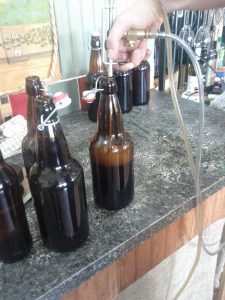British Columbia has the highest alcohol and liquor taxes in all of North America – A depressing thought, given that I work in the industry part time.
On the bright side, this gives me access to a lot of great beer and wine that I wouldn’t necessarily have found otherwise. Unfortunately, good beer costs more! I’m now accustomed to drinking fine craft beer without the budget to pay for it. In an attempt to find a fun, frugal solution to my beer woes, I’ve decided to give brewing my own beer a shot. Now, I’m not talking about the kind of U-brew where you place your order and show up a few weeks later to bottle. I want to mix the ingredients myself, work alongside someone who knows what they’re doing and immerse myself in the process. There is something about creating something yourself that in-stills a deeper respect and appreciation of the art. Last week, my brother and I took the plunge.
As a beginner, I really didn’t know a whole lot about the brewing process, other than the basic equation of mixing grains, water, malt and yeast and fermenting. Being relative noobs, we thought it prudent to enlist professional help; enter Chris – former engineer, cider enthusiast and new proprietor of L’amour du vin. Chris takes a refreshing approach to the u-brew experience. We spent the first 15 minutes chatting about beer, wine and cider. We discussed our inspirations and how we got into the beer and wine scene. Chris will be our guide throughout the process.

Step 1: Choose your kit
Did you really think we’d be doing this from scratch? We’re beginners! I have a colleague who brews his own wort, but for our first attempt a kit offers a great starting point. Kits eliminate some of the more involved steps, but come with the trade-off that you get less control over the style of beer you’re making.
Chris stocks an ample selection of kits from The Brew House. To give a sense of the cost savings here, these kits cost on average $30-$40, and produce ~22 – 23L of beer, so you’re looking at about $3.25 per 6-pack equivalent, plus the cost of any ancillary ingredients or equipment you might need.
I was hoping to make a hoppy American style Pale Ale, but given the style control limitations of the kit I opted for the maltier Oktoberfest style German beer. If you’re a hop fan, it will be difficult to find a kit that truly does a good IPA or Imperial IPA, as the wort already contains the cooked hops – so no control here.
Step 2: Pour concentrated wort into primary fermenter
The biggest benefit of kit brewing is the concentrated wort. Wort is the sweet liquid that comes from mashing grains. To make wort, malted grains are cooked in water, which converts the start in the grain to sugar, which with the addition of yeast will ferment into alcohol.
The wort is then boiled with hops, with the variety and amount dependent on the beer you are brewing. The cooked wort is what comes in the brewing kit – the type and amount of the malt and hops are major determining factors in the flavour profile of the beer, so as you can see much of the style has already been determined in the kit. This is why there are different kits for different styles of beer.
Chris did show us a chart which showed how you can modify existing brew kits by using alternate yeasts, dry hopping and varying the amount of water used. It helps to have two people pour the concentrated malt into the fermenter as this particular package was 15L. (Well, maybe 14.85L after my brother sloshed himself with the wort when positioning it over the fermenter…)
Step 3: Add water and yeast
The kit will tell you how much water to add. We are making a 23 L batch, so we added 8L of water. Chris already had this marked out as a handy line on the primary fermenter. We did not filter our water, although if your municipal or city water isn’t the tastiest, this might be a good idea. Luckily we have some pretty good water in Vancouver.
After adding the yeast package to the wort and water mixture, we stirred it up and closed the primary fermenter. Fermentation will take place over the first 3-5 days, after which Chris will rack our beer over to a glass carboy for ~20 days. This allows the beer to mature and age.
More on bottling and the carbonation process to follow – I’ll remember to take photos for Part 2!